Taylor, Gordon Stuart (Flying Officer)
Killed in Action 1945-February-08
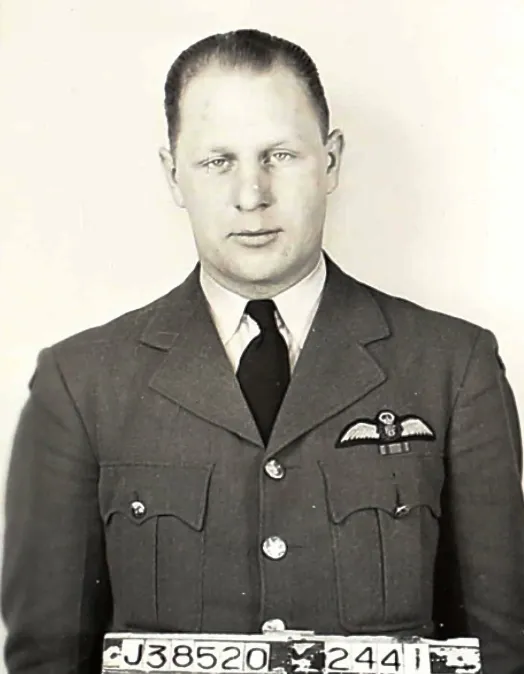

Birth Date: 1919
Born:
Parents: Son of James and Ida Taylor, of Owen Sound, Ontario, Canada.
Spouse:
Home: Owen Sound, Ontario
Enlistment:
Enlistment Date: unkown date
Service
RCAF
Unit
430 Sqn- Squadron
Celeriter Certoque Swiftly and Surely
Base
Rank
Flying Officer
Position
Pilot
Service Numbers
J/38520
Prev: R/69763
Home
Spitfire serial: RM823
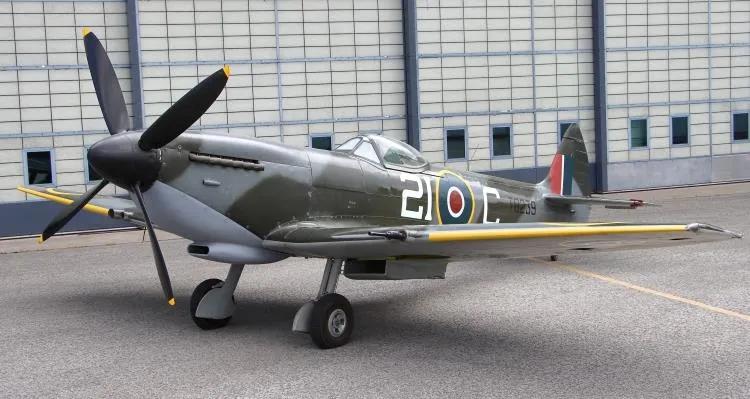
The Supermarine Spitfire is a British single-seat fighter aircraft that was used by the Royal Air Force and other Allied countries before, during, and after World War II. Many variants of the Spitfire were built, using several wing configurations, and it was produced in greater numbers than any other British aircraft. It was also the only British fighter produced continuously throughout the war. The Spitfire continues to be popular among enthusiasts; around 70 remain airworthy, and many more are static exhibits in aviation museums throughout the world.
The Spitfire was designed as a short-range, high-performance interceptor aircraft by R. J. Mitchell, chief designer at Supermarine Aviation Works, which operated as a subsidiary of Vickers-Armstrong from 1928. Mitchell pushed the Spitfire's distinctive elliptical wing with cutting-edge sunken rivets (designed by Beverley Shenstone) to have the thinnest possible cross-section, helping give the aircraft a higher top speed than several contemporary fighters, including the Hawker Hurricane.
The Spitfire had detachable wing tips which were secured by two mounting points at the end of each main wing assembly. When the Spitfire took on a role as a high-altitude fighter (Marks VI and VII and some early Mk VIIIs), the standard wing tips were replaced by extended, "pointed" tips which increased the wingspan from 36 ft 10 in (11.23 m) to 40 ft 2 in (12.24 m). The other wing-tip variation, used by several Spitfire variants, was the "clipped" wing; the standard wing tips were replaced by wooden fairings which reduced the span by 3 ft 6 in (1.07 m). The wing tips used spruce formers for most of the internal structure with a light alloy skin attached using brass screws.
Due to a shortage of Brownings, which had been selected as the new standard rifle calibre machine gun for the RAF in 1934, early Spitfires were fitted with only four guns, with the other four fitted later. Early tests showed that, while the guns worked perfectly on the ground and at low altitudes, they tended to freeze at high altitude, especially the outer wing guns, because the RAF's Brownings had been modified to fire from an open bolt. While this prevented overheating of the cordite used in British ammunition, it allowed cold air to flow through the barrel unhindered. Supermarine did not fix the problem until October 1938, when they added hot air ducts from the rear of the wing-mounted radiators to the guns, and bulkheads around the gunbays to trap the hot air in the wing. Red fabric patches were doped over the gun ports to protect the guns from cold, dirt, and moisture until they were fired.
The first Rolls-Royce Griffon-engined Mk XII flew in August 1942, and first flew operationally with 41 Squadron in April 1943. This mark could nudge 400 mph (640 km/h) in level flight and climb to an altitude of 33,000 ft (10,000 m) in under nine minutes. As American fighters took over the long-range escorting of USAAF daylight bombing raids, the Griffon-engined Spitfires progressively took up the tactical air superiority role, and played a major role in intercepting V-1 flying bombs, while the Merlin-engined variants (mainly the Mk IX and the Packard-engined Mk XVI) were adapted to the fighter-bomber role. Although the later Griffon-engined marks lost some of the favourable handling characteristics of their Merlin-powered predecessors, they could still outmanoeuvre their main German foes and other, later American and British-designed fighters.Wikipedia
![]() Wikipedia Supermarine Spitfire
Wikipedia Supermarine Spitfire
Unit Desciption
430 Sqn Celeriter Certoque ("City of Sudbury")
h4>History of the Squadron during World War II (Aircraft: Tomahawk I, III, Mustang I, Spitfire FR Mk XIV)
[Note that the squadron crest and motto were not given to the squadron until after WWII. During WWII the squadron had neither crest nor motto.] This squadron was the third and last Army Co-operation squadron formed by the RCAF overseas in WWII. It was formed on January 1, 1943 at Hartford Bridge, Hampshire, UK ![]() and was designated Fighter Reconnaissance on June 28, 1943. The squadron carried out photographic reconnaissance for the D-Day invasion planners, and later for the air attacks on the V-1 flying bomb "No-Ball" sites. After the D-Day landings it provided tactical reconnaissance for ground forces in NW Europe. Having been formed as part of No 39 (RCAF) Wing, it joined No 11 Group of Fighter Command in June of 1943, then 2nd Tactical Air Force, No 129 (RCAF) Wing, based at Ashford, Kent
and was designated Fighter Reconnaissance on June 28, 1943. The squadron carried out photographic reconnaissance for the D-Day invasion planners, and later for the air attacks on the V-1 flying bomb "No-Ball" sites. After the D-Day landings it provided tactical reconnaissance for ground forces in NW Europe. Having been formed as part of No 39 (RCAF) Wing, it joined No 11 Group of Fighter Command in June of 1943, then 2nd Tactical Air Force, No 129 (RCAF) Wing, based at Ashford, Kent ![]() and Gatwick, Surrey
and Gatwick, Surrey ![]() . It transferred to No 128 (RCAF) Wing from April to July 1944, during which time it moved to France. From July 1944 to May1945, it was part of No 39 (RCAF) Wing and moved to different bases with the armies as they advanced through France, Belgium, the Netherlands and Germany. The squadron was disbanded at Luneburg, Germany
. It transferred to No 128 (RCAF) Wing from April to July 1944, during which time it moved to France. From July 1944 to May1945, it was part of No 39 (RCAF) Wing and moved to different bases with the armies as they advanced through France, Belgium, the Netherlands and Germany. The squadron was disbanded at Luneburg, Germany ![]() in August of 1945. During its operations, it flew Curtiss Tomahawk Mk I and III (but not on operations) in January and February 1943. From January 1943 it flew North American Mustang Mk I, finally ending up with Spitfire FR Mk XIV aircraft in November 1944.
in August of 1945. During its operations, it flew Curtiss Tomahawk Mk I and III (but not on operations) in January and February 1943. From January 1943 it flew North American Mustang Mk I, finally ending up with Spitfire FR Mk XIV aircraft in November 1944.
The squadron flew 4946 sorties for the loss of 29 aircraft: it destroyed 31 locomotives and other vehicles. It won 9 DFCs, 1 Air Medal (USA) and 1 Croix de Guerre (France). Battle Honours were: Fortress Europe 1943-44, France and Germany 1944-45, Normandy 1944, Arnhem, Rhine.Wikipedia, Kostenuk and Griffin
Maps for Movements of 430 Squadron 1943-45
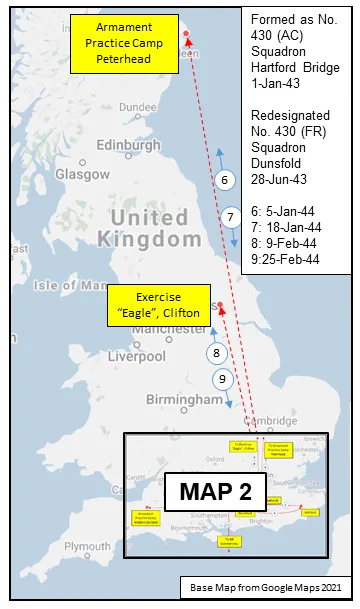
MAP 1: 430 Squadron Movements in UK 1943-44 (right-click on image to display enlarged in new tab)
|
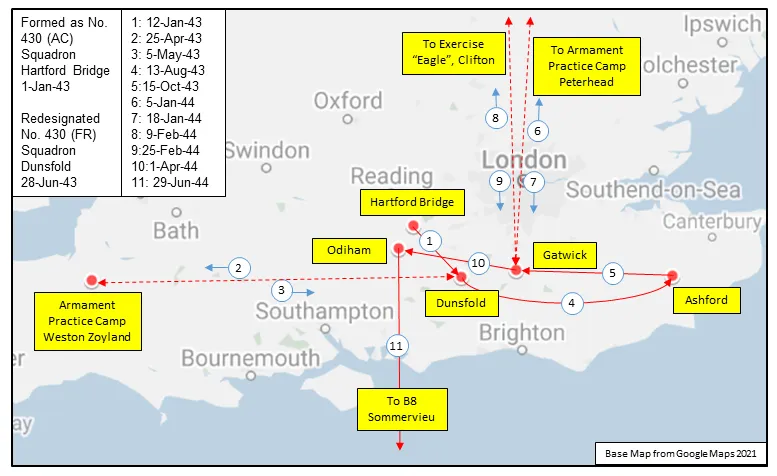
MAP 2: 430 Squadron Movements in Southern England 1943-44 (detail of Map 1)
|
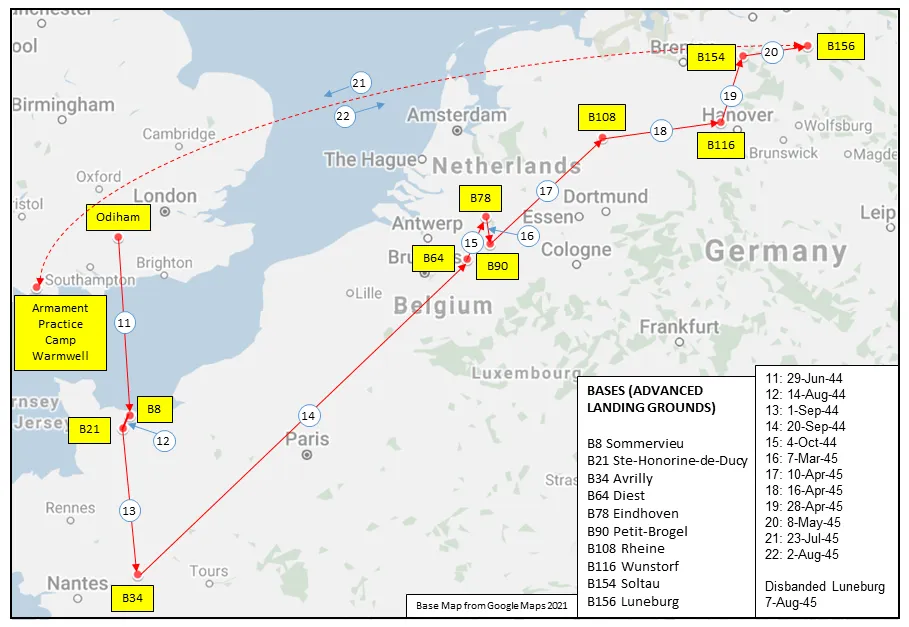
430 Squadron History Summary 1943-45
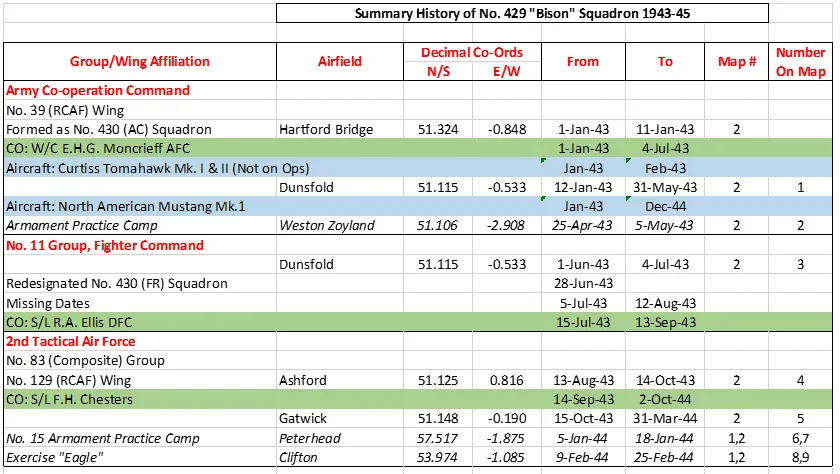
430 Squadron History Summary 1943-45 Page 2
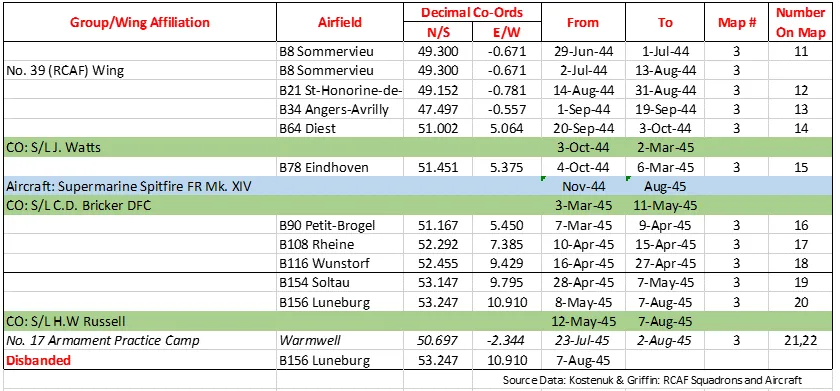
History of the Squadron Post-WWII (Aircraft: Sabre 2, 5, 6, Starfighter, Twin Huey, Kiowa, Griffon)
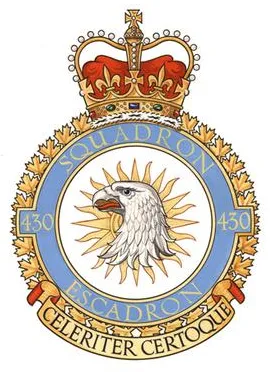
The squadron was re-formed as a Fighter unit at North Bay, Ontario ![]() on 1 November 1951. It was given the nickname Silver Falcon. With Sabre aircraft, the squadron joined No. 2 (Fighter) Wing at Grostenquin, France
on 1 November 1951. It was given the nickname Silver Falcon. With Sabre aircraft, the squadron joined No. 2 (Fighter) Wing at Grostenquin, France ![]() in September 1952. Selected as one of eight squadrons in No. 1 Air Division Europe to be re-equipped with CF-104 aircraft for a nuclear strike role, it was deactivated on 1 June 1963 and reactivated as Strike Attack on 30 September. When No. 2 Wing was disbanded on 24 February 1964, the squadron moved to No. 3 Wing at Zweibrucken, Germany
in September 1952. Selected as one of eight squadrons in No. 1 Air Division Europe to be re-equipped with CF-104 aircraft for a nuclear strike role, it was deactivated on 1 June 1963 and reactivated as Strike Attack on 30 September. When No. 2 Wing was disbanded on 24 February 1964, the squadron moved to No. 3 Wing at Zweibrucken, Germany![]() . On 1 February 1968 the squadron was integrated into the Canadian Armed Forces. The squadron moved to 1 Wing Lahr, West Germany
. On 1 February 1968 the squadron was integrated into the Canadian Armed Forces. The squadron moved to 1 Wing Lahr, West Germany ![]() in February 1969 until it was disbanded in May 1970.
in February 1969 until it was disbanded in May 1970.
The unit reformed again in 1971 as a French-language Canadian Forces tactical helicopter squadron at Valcartier ![]() and known officially as 430e Escadron tactique d'hélicoptères. There it operated the Bell CH-136 Kiowa and the Bell CH-135 Twin Huey in support of 5 Canadian Mechanized Brigade Group. The unit transitioned to the CH-146 Griffon in 1994. 430 THS has participated in several international missions, in locations including Haiti, Bosnia-Herzegovina, Kosovo, Afghanistan, Iraq, and Mali.
and known officially as 430e Escadron tactique d'hélicoptères. There it operated the Bell CH-136 Kiowa and the Bell CH-135 Twin Huey in support of 5 Canadian Mechanized Brigade Group. The unit transitioned to the CH-146 Griffon in 1994. 430 THS has participated in several international missions, in locations including Haiti, Bosnia-Herzegovina, Kosovo, Afghanistan, Iraq, and Mali.